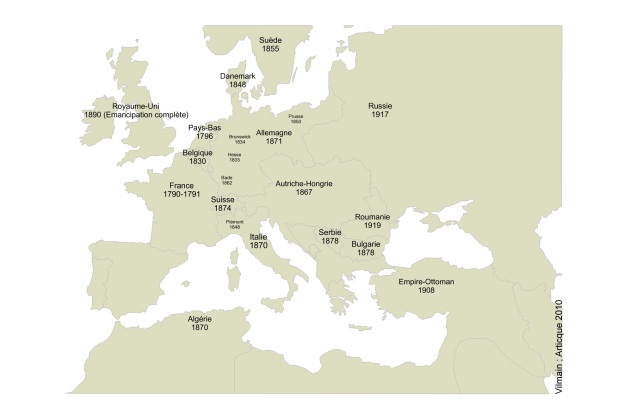19th century Jewry in Europe: emancipation and assimilation
The move towards the emancipation of the Jews of Europe that started at the end of the 18th century represents a shift in their history at least as momentous as the Babylonian exile (586 B.C.E) or the destruction of the Second Temple (70). Indeed, most European countries followed the model adopted by France in 1790-91, which led the Jews to redefine their identity, notably their relation to community on the one hand and to religion on the other. Emancipation and assimilation jointly drove the transformation of Judaism in Europe in the 19th century: the former refers to the juridical fact of the Jews' entitlement to citizenship, and the latter to the social fact of their forfeiting closed communal life to join society at large.
The emancipation/assimilation process followed no chronological imperative at all. Assimilation actually preceded emancipation in Germany, the Low Countries and the United Kingdom. Indeed the national unit is misleading. In France, in 1790-91, the Jews from the Atlantic seaboard were already assimilated, which was not the case for those in the Comtat Venaissin or Alsace. The same goes for the Austro-Hungarian Empire in 1869 where Austrian and Hungarian Jews were well on their way to assimilation, which was not or barely the case in Galicia while marked differences endured in Russia right up to 1917
Assimilation was encouraged by the Maskilim[3] and even, to a certain extent, by a few rabbis, mostly the proponents of a reformed or liberal Judaism. The general mood was buoyant. Emancipation was often seen as a harbinger of the redemption of Israel. Assimilation was assorted, especially in some German States, with a reform of Judaism grounded in the principle that the oral law is not immutable. A number of more symbolic traits were talked up. The term “temple' was preferred to that of synagogue, sermons were preached in the vernacular, organs were brought in, references to Zion removed. The movement, sporadic at first, solidified around the figure of Abraham Geiger[1] and spread later to other parts of Europe and to the United States. Geiger and other reform minded rabbis' choices were not endorsed by all. Orthodox Jews resisted and the reformed movement split for the first time. In 1854 the massorti (lit. “traditional”) movement, open to modernity but still conservative, coalesced around Zacharias Frankel[2] .







